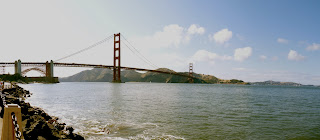*NOTE: Did not print out puzzles but worked on them simultaneously while both on iChat. Additionally, the puzzles didn't require for us to do any physical modifications/writings and were purely visually done.
Identify which spiral only uses one rope and which ones uses two ropes.
When initially seeing the two spirals, I was a little overwhelmed. I knew that they were supposed to be different but at first glance, they seem identical. So I split the work and randomly chose the left one to dissect first. I followed the loop from end into the middle but my eyes got weary trying to follow the loop in the center. So I re-strategized and mentally split the loop in half and followed one line at a time into the middle. There I found that the line re-looped outwards from the center and would eventually work its way back to my starting point of the spiral. Once I established that the left spiral was the one-roped spiral, it was somehow easier for me to see that the right one consists of the different loops/ropes. Then when I took a step back to look at them as a whole picture, it became more apparent that they were two different spirals and that the right, two-roped spiral looks less complex than the left hand spiral.
Wesley Wong, my co-puzzle solver, also started his strategy by picking a spiral at random. He just so happened to choose the right spiral first and also traced from end into the center. When he found it was a closed loop at the center, he checked the left spiral as well, just to verify. He noticed at this time that although similar, these spirals did not have the same pattern (pattern-seeking strategy). He also noticed that the right one was more simple of a swirl than the left and chose to solve that one first.
Which month of the year does this stand for?
Immediately, I look at it holistically and think it's symbolic for a month and theses abstract shapes stood for something. With this top-down sort of strategy, I made the puzzle more complex and sort of unsolvable. I overlooked the features of the shape and got hung up on the goal of trying to find the relationship between these "symbols" and a month. I tried to find similarities of its shape and even the colors to any of the months but alas, I was beat to the finish line.
Wesley typed "July" as his answer before I got to solve it myself. At first, I still could not see it. He then explained that at first, he also thought the colors were indicative of the solution to the puzzle. Understandably, the bright colors featured is highly impacting and grabs your attention. Partly why I chose to even solve this puzzle was because of its colorful attribute. Wesley quickly gathered that something else was grabbing his attention, other than the colors, so he separated each shape's features. To him, he saw j-shapes and the u-shape when he took off the tops in his mental imagery. After establishing that there's at least one "j" and one "u"-like characters, he went down the list of the months and matched it to july. His use of bottom-up visualizing helped him solve the problem quicker, especially that this puzzle is harder to visualize when one looks at the whole picture. In fact if I had just started physically looking from bottom and upwards and mentally dissect the shapes into parts, "July" is easier to locate.


















